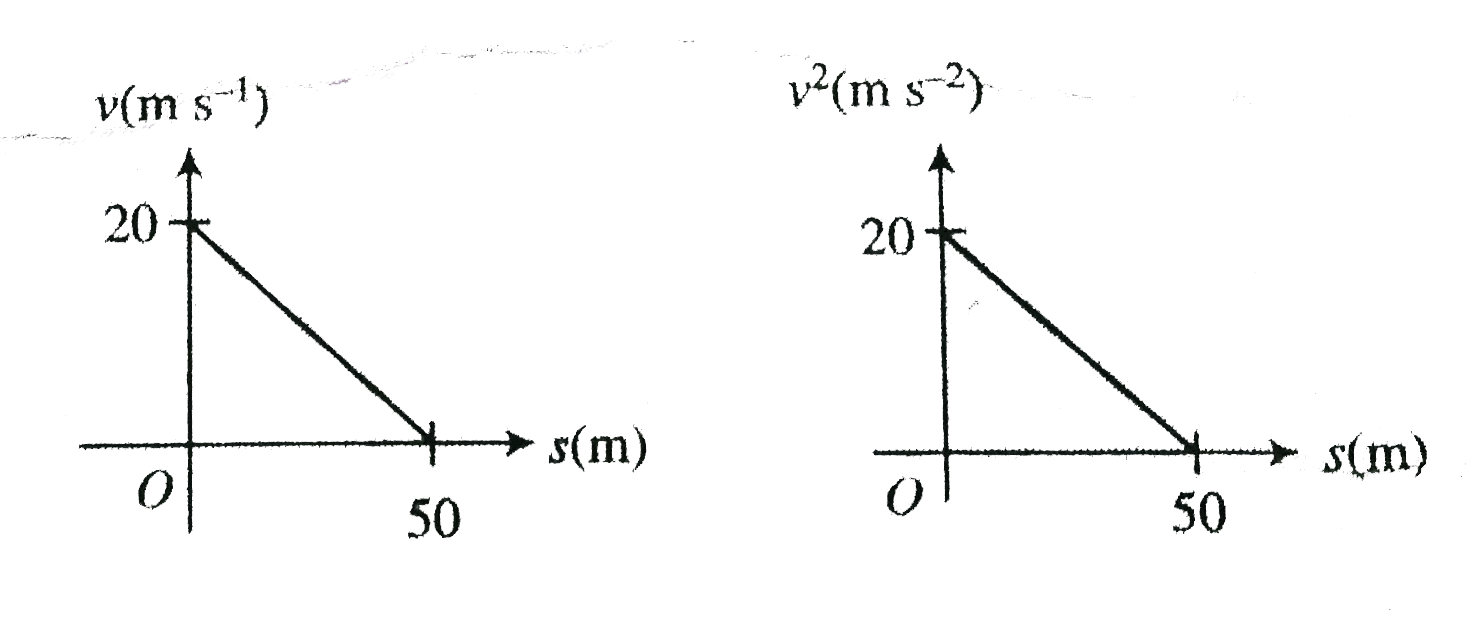A particle moves in a circular path such that its speed varies with distance as , where is a positive constant. Find the acceleration of the particle after traversing a distance .
To find the acceleration of a particle moving in a circular path where its speed varies with distance as v=√s, we need to consider both the centripetal and tangential components of acceleration.
1. Identify the given relationship:
The speed v of the particle is given by:
v=α√s
where α is a positive constant.
2. Calculate the centripetal acceleration:
The centripetal acceleration ac is given by the formula:
ac=v2R
Substituting v from the given relationship:
ac=(α√s)2R=α2sR
3. Calculate the tangential acceleration:
The tangential acceleration at can be calculated using the relationship:
at=dvdt=vdvds
First, we need to find dvds. From v=α√s, we differentiate:
dvds=α2√s
Now substituting back into the equation for at:
at=vdvds=α√s⋅α2√s=α22
4. Combine the accelerations:
The total acceleration a is the vector sum of the centripetal and tangential accelerations. Since they are perpendicular, we can find the resultant acceleration using the Pythagorean theorem:
a=√a2c+a2t
Substituting the values we found:
a=√(α2sR)2+(α22)2
Simplifying this:
a=√α4s2R2+α44=α2√s2R2+14
5. Final Result:
Therefore, the acceleration of the particle after traversing a distance s is:
a=α2√s2R2+14
The speed v of the particle is given by:
v=α√s
where α is a positive constant.
The centripetal acceleration ac is given by the formula:
ac=v2R
Substituting v from the given relationship:
ac=(α√s)2R=α2sR
The tangential acceleration at can be calculated using the relationship:
at=dvdt=vdvds
First, we need to find dvds. From v=α√s, we differentiate:
dvds=α2√s
Now substituting back into the equation for at:
at=vdvds=α√s⋅α2√s=α22
The total acceleration a is the vector sum of the centripetal and tangential accelerations. Since they are perpendicular, we can find the resultant acceleration using the Pythagorean theorem:
a=√a2c+a2t
Substituting the values we found:
a=√(α2sR)2+(α22)2
Simplifying this:
a=√α4s2R2+α44=α2√s2R2+14
Therefore, the acceleration of the particle after traversing a distance s is:
a=α2√s2R2+14
Topper's Solved these Questions
- KINEMATICS-2BOOK - CENGAGE PHYSICS ENGLISHCHAPTER - KINEMATICS-2EXERCISE - Solved Examples
7 Videos
- KINEMATICS-2BOOK - CENGAGE PHYSICS ENGLISHCHAPTER - KINEMATICS-2EXERCISE - Exercise 5.1
15 Videos
- KINEMATICS-1BOOK - CENGAGE PHYSICS ENGLISHCHAPTER - KINEMATICS-1EXERCISE - Integer
9 Videos
- KINETIC THEORY OF GASESBOOK - CENGAGE PHYSICS ENGLISHCHAPTER - KINETIC THEORY OF GASESEXERCISE - Compression
2 Videos
Similar Questions
A particle moves in a circular path such that its speed v varies with distance as V=α√s where α is a positive constant. Find the acceleration of the particle after traversing a distance s.
View SolutionA particle moves in a circular path such that its speed v varies with distance s as v=α√s where α is a positive constant. If the acceleration of the particle after traversing a distance s is [α2√x+s2R2] find x.
View SolutionA particle moves in a circular path such that its speed v varies with distance as v=α√s where α is a positive constant. Find the acceleration of particle after traversing a distance S?
View SolutionA particle is moving on a circular path with speed given by v= αt, where α is a constant. Find the acceleration of the particle at the instant when it has covered the nth fraction of the circle.
View SolutionThe v−s and v2−s graph are given for two particles. Find the accelerations of the particles at s=0.
 .
.
View SolutionA particle of mass 1 kg moves in a circular path of radius 1 m such that its speed varies with time as per equation v=3t2m/s where time t is in seconds. The power delivered by the force acting on the paritcle at t=1s, is :−
View SolutionA particle is moving on a circular path of radius 1 m with 2 m/s. If speed starts increasing at a rate of 2m/s2, then acceleration of particle is
View SolutionA particle moves in a circle of radius 20 cm. Its linear speed is given by v=(3t2+5t) where t is in second and v is in m/s. Find the resultant acceleration at t = 1s.
View SolutionA particle moves in a circle of radius 1 cm at a speed given v=2t, where v is cm/s and t is in seconds. Total acceleration of the particle at t=1 second is 2√ncm/s2. Find value of n.
View SolutionA particle is moving on a circular path with constant speed, then its acceleration will be constant in
View Solution
